technical specifications Alfa Romeo Brera/Spider 2008 Owner handbook (in English)
[x] Cancel search | Manufacturer: ALFA ROMEO, Model Year: 2008, Model line: Brera/Spider, Model: Alfa Romeo Brera/Spider 2008Pages: 270, PDF Size: 3.93 MB
Page 126 of 270
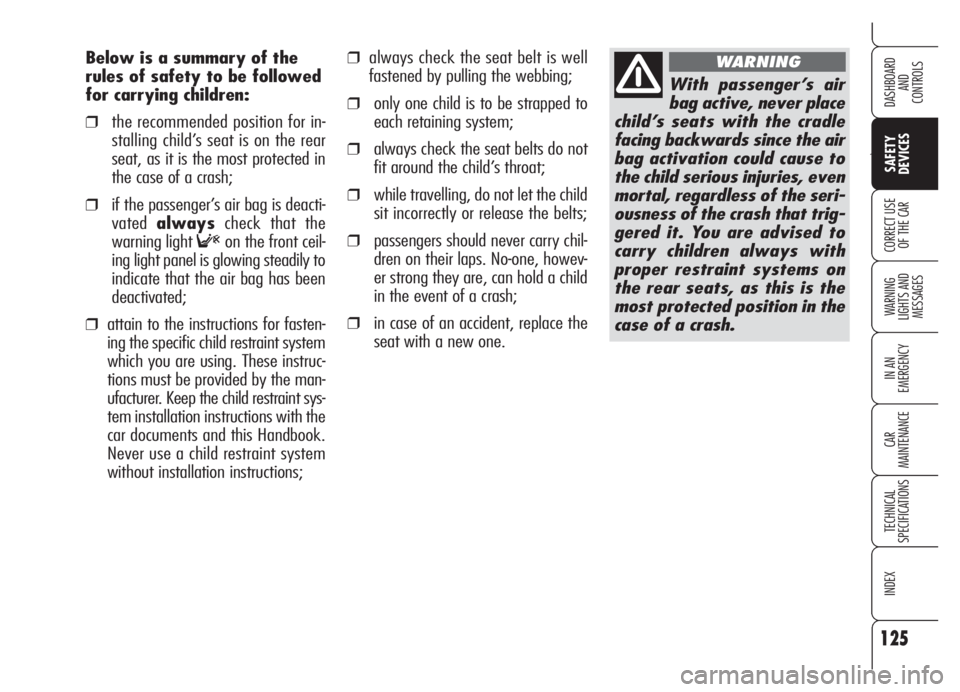
125
Ù
SAFETY
DEVICES
WARNING
LIGHTS AND
MESSAGES
IN AN
EMERGENCY
CAR
MAINTENANCE
TECHNICAL
SPECIFICATIONS
INDEX
DASHBOARD
AND
CONTROLS
CORRECT USE
OF THE CAR
❒always check the seat belt is well
fastened by pulling the webbing;
❒only one child is to be strapped to
each retaining system;
❒always check the seat belts do not
fit around the child’s throat;
❒while travelling, do not let the child
sit incorrectly or release the belts;
❒passengers should never carry chil-
dren on their laps. No-one, howev-
er strong they are, can hold a child
in the event of a crash;
❒in case of an accident, replace the
seat with a new one. Below is a summary of the
rules of safety to be followed
for carrying children:
❒the recommended position for in-
stalling child’s seat is on the rear
seat, as it is the most protected in
the case of a crash;
❒if the passenger’s air bag is deacti-
vatedalwayscheck that the
warning light
Fon the front ceil-
ing light panel is glowing steadily to
indicate that the air bag has been
deactivated;
❒attain to the instructions for fasten-
ing the specific child restraint system
which you are using. These instruc-
tions must be provided by the man-
ufacturer. Keep the child restraint sys-
tem installation instructions with the
car documents and this Handbook.
Never use a child restraint system
without installation instructions;
With passenger’s air
bag active, never place
child’s seats with the cradle
facing backwards since the air
bag activation could cause to
the child serious injuries, even
mortal, regardless of the seri-
ousness of the crash that trig-
gered it. You are advised to
carry children always with
proper restraint systems on
the rear seats, as this is the
most protected position in the
case of a crash.
WARNING
Page 127 of 270
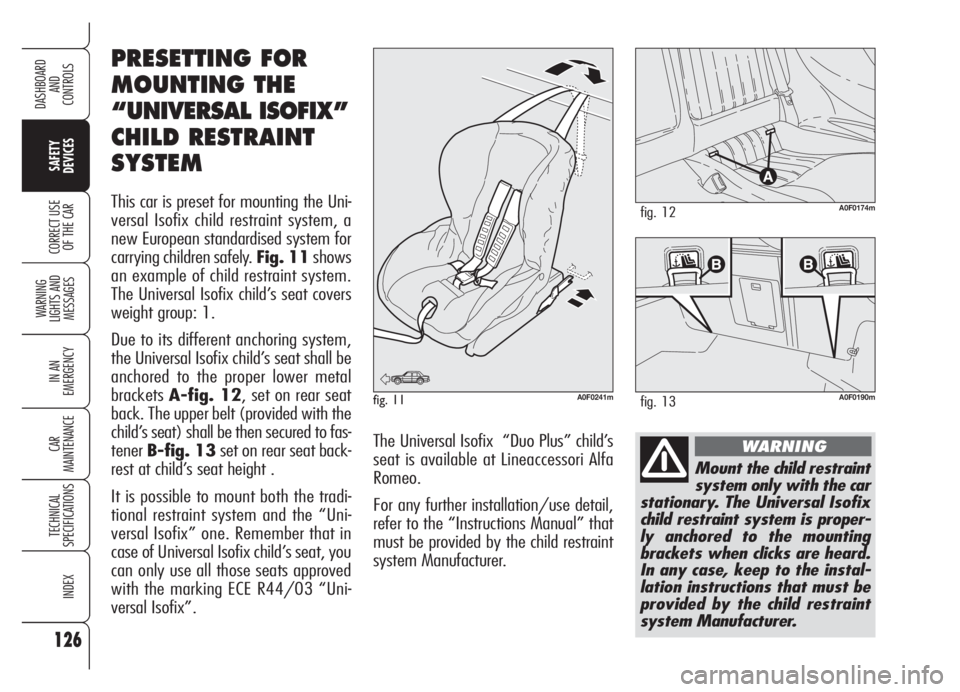
126
SAFETY
DEVICES
WARNING
LIGHTS AND
MESSAGES
IN AN
EMERGENCY
CAR
MAINTENANCE
TECHNICAL
SPECIFICATIONS
INDEX
DASHBOARD
AND
CONTROLS
CORRECT USE
OF THE CAR
Mount the child restraint
system only with the car
stationary. The Universal Isofix
child restraint system is proper-
ly anchored to the mounting
brackets when clicks are heard.
In any case, keep to the instal-
lation instructions that must be
provided by the child restraint
system Manufacturer.
WARNING
PRESETTING FOR
MOUNTING THE
“UNIVERSAL ISOFIX”
CHILD RESTRAINT
SYSTEM
This car is preset for mounting the Uni-
versal Isofix child restraint system, a
new European standardised system for
carrying children safely. Fig. 11shows
an example of child restraint system.
The Universal Isofix child’s seat covers
weight group: 1.
Due to its different anchoring system,
the Universal Isofix child’s seat shall be
anchored to the proper lower metal
bracketsA-fig. 12, set on rear seat
back. The upper belt (provided with the
child’s seat) shall be then secured to fas-
tenerB-fig. 13set on rear seat back-
rest at child’s seat height .
It is possible to mount both the tradi-
tional restraint system and the “Uni-
versal Isofix” one. Remember that in
case of Universal Isofix child’s seat, you
can only use all those seats approved
with the marking ECE R44/03 “Uni-
versal Isofix”.The Universal Isofix “Duo Plus” child’s
seat is available at Lineaccessori Alfa
Romeo.
For any further installation/use detail,
refer to the “Instructions Manual” that
must be provided by the child restraint
system Manufacturer.A0F0174mfig. 12
fig. 11A0F0241mA0F0190mfig. 13
Page 128 of 270
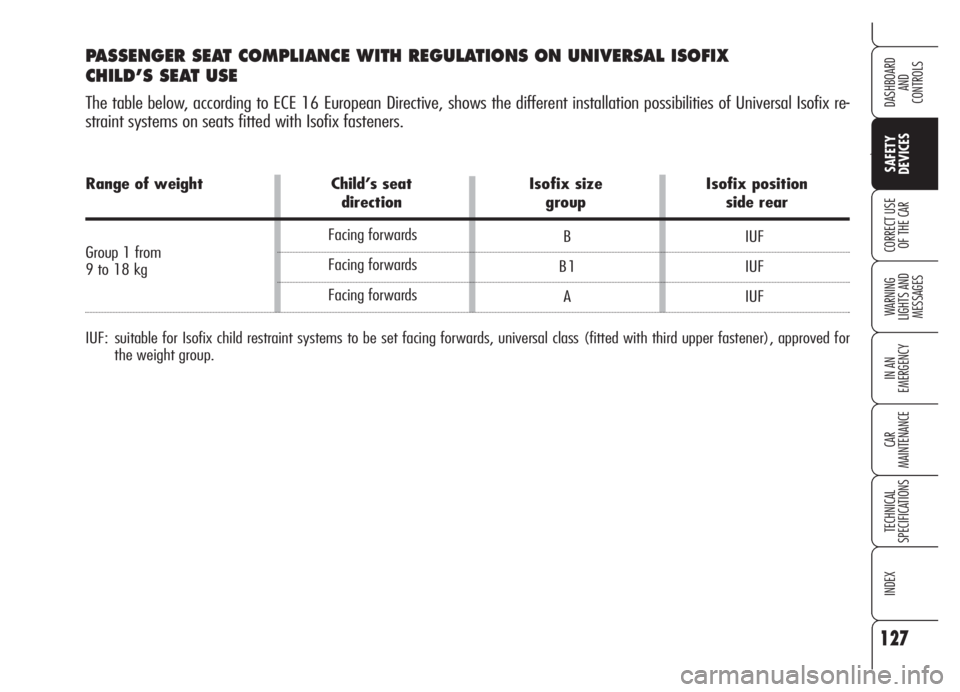
Range of weight Child’s seat Isofix size Isofix position
direction group side rear
Group 1 from
9 to 18 kg
127
Ù
SAFETY
DEVICES
WARNING
LIGHTS AND
MESSAGES
IN AN
EMERGENCY
CAR
MAINTENANCE
TECHNICAL
SPECIFICATIONS
INDEX
DASHBOARD
AND
CONTROLS
CORRECT USE
OF THE CAR
IUF: suitable for Isofix child restraint systems to be set facing forwards, universal class (fitted with third upper fastener), approved for
the weight group.
PASSENGER SEAT COMPLIANCE WITH REGULATIONS ON UNIVERSAL ISOFIX
CHILD’S SEAT USE
The table below, according to ECE 16 European Directive, shows the different installation possibilities of Universal Isofix re-
straint systems on seats fitted with Isofix fasteners.
B
B1
AIUF
IUF
IUF Facing forwards
Facing forwards
Facing forwards
Page 129 of 270
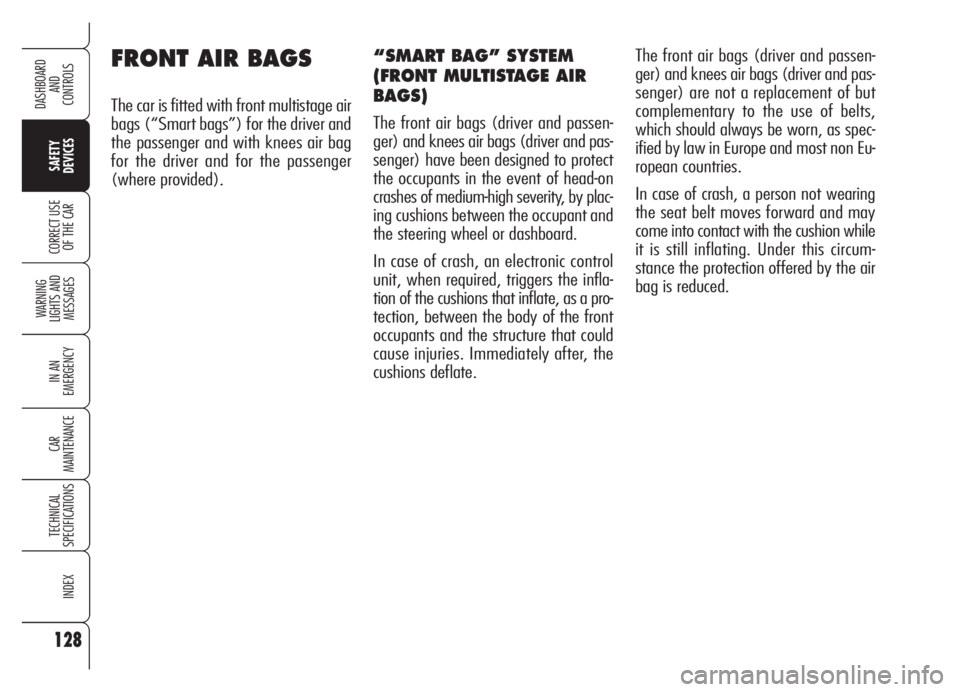
128
SAFETY
DEVICES
WARNING
LIGHTS AND
MESSAGES
IN AN
EMERGENCY
CAR
MAINTENANCE
TECHNICAL
SPECIFICATIONS
INDEX
DASHBOARD
AND
CONTROLS
CORRECT USE
OF THE CAR
FRONT AIR BAGS
The car is fitted with front multistage air
bags (“Smart bags”) for the driver and
the passenger and with knees air bag
for the driver and for the passenger
(where provided).The front air bags (driver and passen-
ger) and knees air bags (driver and pas-
senger) are not a replacement of but
complementary to the use of belts,
which should always be worn, as spec-
ified by law in Europe and most non Eu-
ropean countries.
In case of crash, a person not wearing
the seat belt moves forward and may
come into contact with the cushion while
it is still inflating. Under this circum-
stance the protection offered by the air
bag is reduced.
“SMART BAG” SYSTEM
(FRONT MULTISTAGE AIR
BAGS)
The front air bags (driver and passen-
ger) and knees air bags (driver and pas-
senger) have been designed to protect
the occupants in the event of head-on
crashes of medium-high severity, by plac-
ing cushions between the occupant and
the steering wheel or dashboard.
In case of crash, an electronic control
unit, when required, triggers the infla-
tion of the cushions that inflate, as a pro-
tection, between the body of the front
occupants and the structure that could
cause injuries. Immediately after, the
cushions deflate.
Page 130 of 270
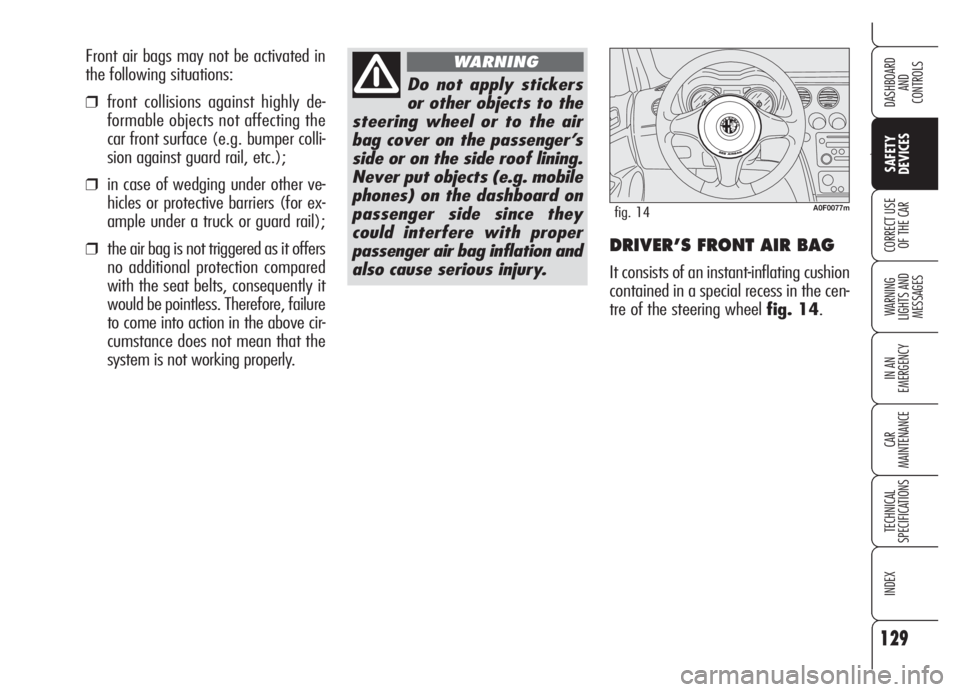
129
Ù
SAFETY
DEVICES
WARNING
LIGHTS AND
MESSAGES
IN AN
EMERGENCY
CAR
MAINTENANCE
TECHNICAL
SPECIFICATIONS
INDEX
DASHBOARD
AND
CONTROLS
CORRECT USE
OF THE CARDRIVER’S FRONT AIR BAG
It consists of an instant-inflating cushion
contained in a special recess in the cen-
tre of the steering wheelfig. 14. Front air bags may not be activated in
the following situations:
❒front collisions against highly de-
formable objects not affecting the
car front surface (e.g. bumper colli-
sion against guard rail, etc.);
❒in case of wedging under other ve-
hicles or protective barriers (for ex-
ample under a truck or guard rail);
❒the air bag is not triggered as it offers
no additional protection compared
with the seat belts, consequently it
would be pointless. Therefore, failure
to come into action in the above cir-
cumstance does not mean that the
system is not working properly.
Do not apply stickers
or other objects to the
steering wheel or to the air
bag cover on the passenger’s
side or on the side roof lining.
Never put objects (e.g. mobile
phones) on the dashboard on
passenger side since they
could interfere with proper
passenger air bag inflation and
also cause serious injury.
WARNING
A0F0077mfig. 14
Page 131 of 270
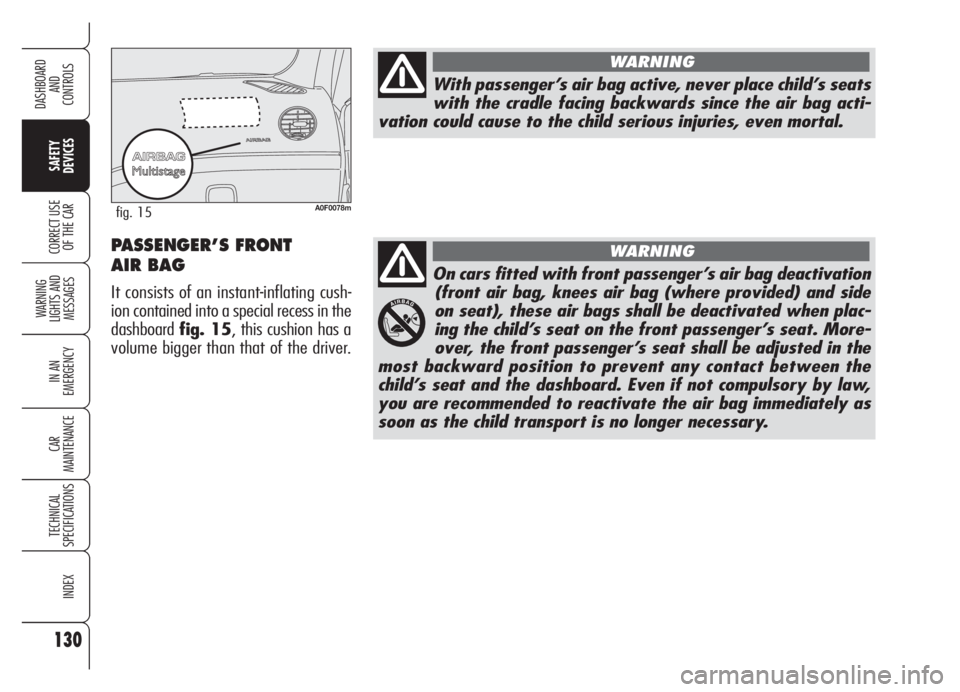
130
SAFETY
DEVICES
WARNING
LIGHTS AND
MESSAGES
IN AN
EMERGENCY
CAR
MAINTENANCE
TECHNICAL
SPECIFICATIONS
INDEX
DASHBOARD
AND
CONTROLS
CORRECT USE
OF THE CAR
On cars fitted with front passenger’s air bag deactivation
(front air bag, knees air bag (where provided) and side
on seat), these air bags shall be deactivated when plac-
ing the child’s seat on the front passenger’s seat. More-
over, the front passenger’s seat shall be adjusted in the
most backward position to prevent any contact between the
child’s seat and the dashboard. Even if not compulsory by law,
you are recommended to reactivate the air bag immediately as
soon as the child transport is no longer necessary.
A0F0078mfig. 15
With passenger’s air bag active, never place child’s seats
with the cradle facing backwards since the air bag acti-
vation could cause to the child serious injuries, even mortal.
WARNING
WARNINGPASSENGER’S FRONT
AIR BAG
It consists of an instant-inflating cush-
ion contained into a special recess in the
dashboardfig. 15, this cushion has a
volume bigger than that of the driver.
Page 132 of 270
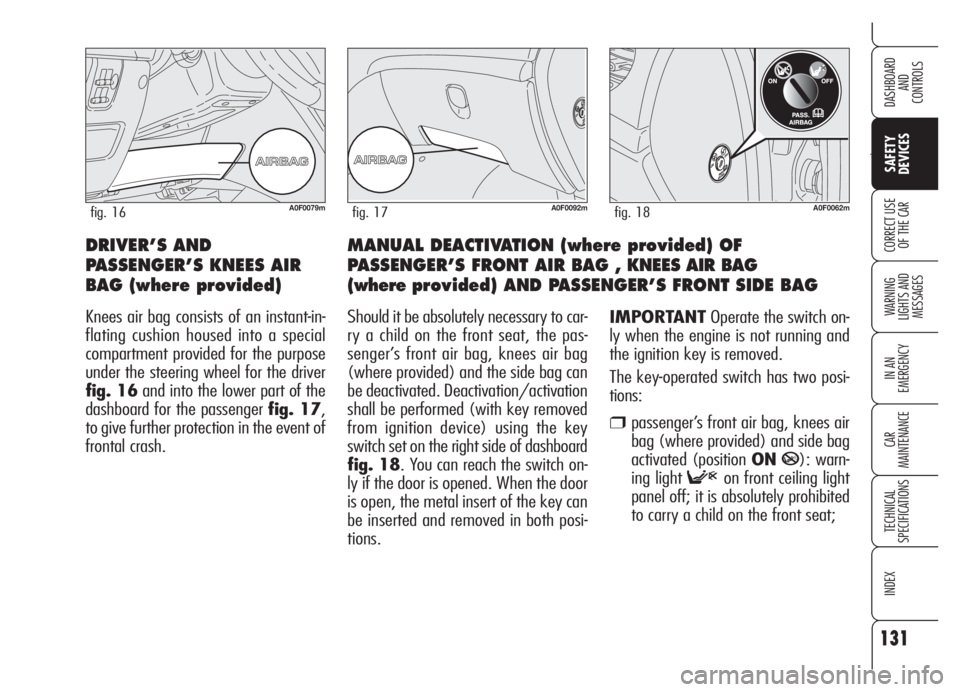
131
Ù
SAFETY
DEVICES
WARNING
LIGHTS AND
MESSAGES
IN AN
EMERGENCY
CAR
MAINTENANCE
TECHNICAL
SPECIFICATIONS
INDEX
DASHBOARD
AND
CONTROLS
CORRECT USE
OF THE CARMANUAL DEACTIVATION (where provided) OF
PASSENGER’S FRONT AIR BAG , KNEES AIR BAG
(whereprovided) AND PASSENGER’S FRONT SIDE BAG DRIVER’S AND
PASSENGER’S KNEES AIR
BAG (where provided)
Knees air bag consists of an instant-in-
flating cushion housed into a special
compartment provided for the purpose
under the steering wheel for the driver
fig. 16and into the lower part of the
dashboard for the passenger fig. 17,
to give further protection in the event of
frontal crash.
A0F0092mfig. 17A0F0079mfig. 16
Should it be absolutely necessary to car-
ry a child on the front seat, the pas-
senger’s front air bag, knees air bag
(where provided) and the side bag can
be deactivated. Deactivation/activation
shall be performed (with key removed
from ignition device) using the key
switch set on the right side of dashboard
fig. 18. You can reach the switch on-
ly if the door is opened. When the door
is open, the metal insert of the key can
be inserted and removed in both posi-
tions.IMPORTANTOperate the switch on-
ly when the engine is not running and
the ignition key is removed.
The key-operated switch has two posi-
tions:
❒passenger’s front air bag, knees air
bag (where provided) and side bag
activated (position ONP): warn-
ing light Fon front ceiling light
panel off; it is absolutely prohibited
to carry a child on the front seat;
A0F0062mfig. 18
Page 133 of 270
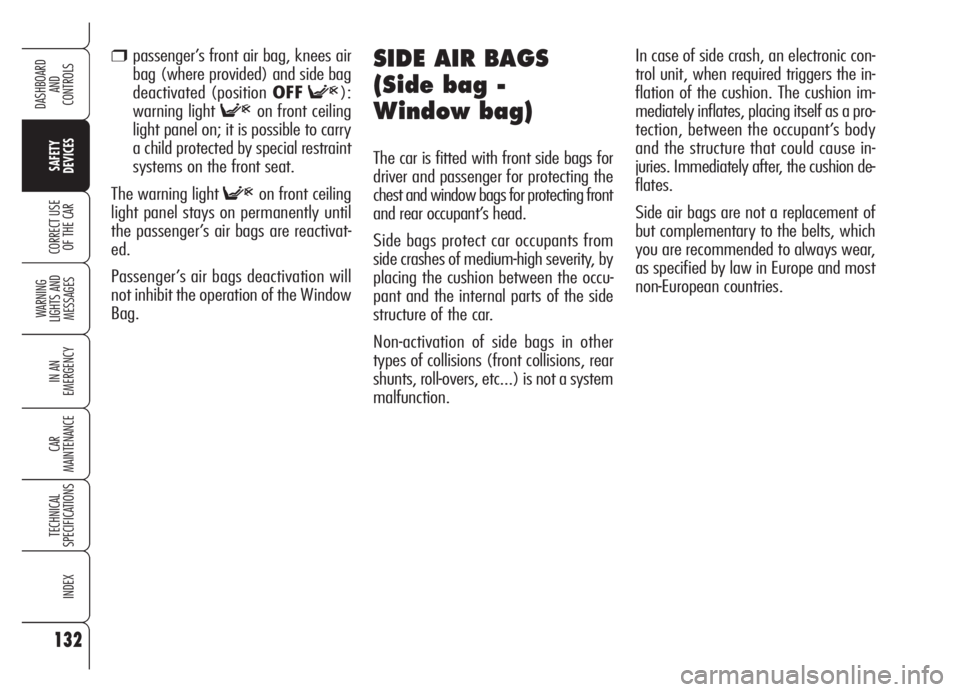
132
SAFETY
DEVICES
WARNING
LIGHTS AND
MESSAGES
IN AN
EMERGENCY
CAR
MAINTENANCE
TECHNICAL
SPECIFICATIONS
INDEX
DASHBOARD
AND
CONTROLS
CORRECT USE
OF THE CAR
❒passenger’s front air bag, knees air
bag (where provided) and side bag
deactivated (positionOFFF):
warning light Fon front ceiling
light panel on; it is possible to carry
a child protected by special restraint
systems on the front seat.
The warning light Fon front ceiling
light panel stays on permanently until
the passenger’s air bags are reactivat-
ed.
Passenger’s air bags deactivation will
not inhibit the operation of the Window
Bag.SIDE AIR BAGS
(Side bag -
Window bag)
The car is fitted with front side bags for
driver and passenger for protecting the
chest and window bags for protecting front
and rear occupant’s head.
Side bags protect car occupants from
side crashes of medium-high severity, by
placing the cushion between the occu-
pant and the internal parts of the side
structure of the car.
Non-activation of side bags in other
types of collisions (front collisions, rear
shunts, roll-overs, etc...) is not a system
malfunction.In case of side crash, an electronic con-
trol unit, when required triggers the in-
flation of the cushion. The cushion im-
mediately inflates, placing itself as a pro-
tection, between the occupant’s body
and the structure that could cause in-
juries. Immediately after, the cushion de-
flates.
Side air bags are not a replacement of
but complementary to the belts, which
you are recommended to always wear,
as specified by law in Europe and most
non-European countries.
Page 134 of 270
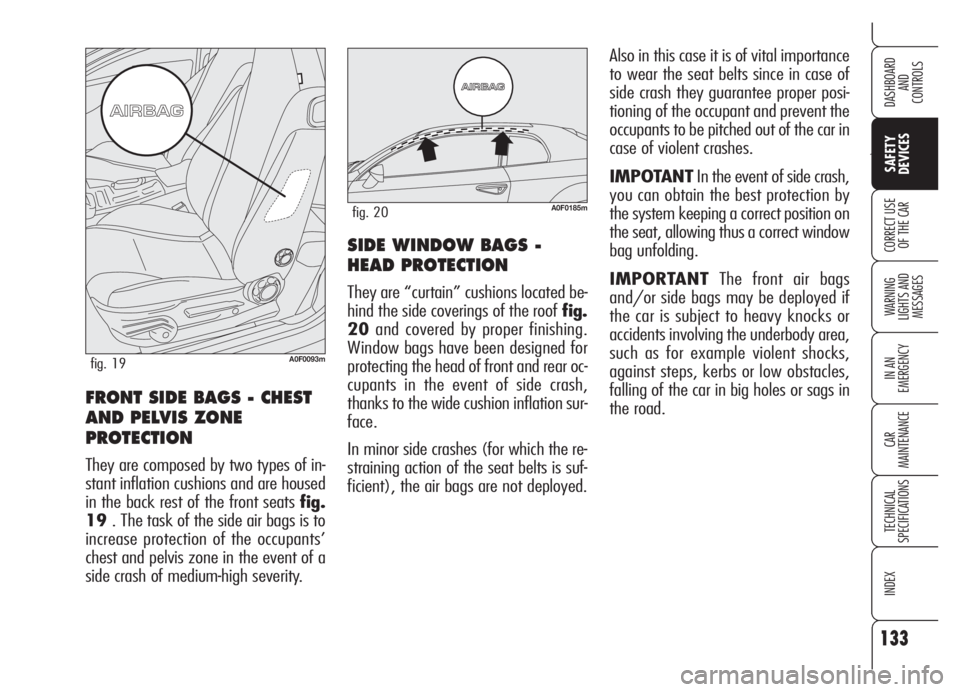
133
Ù
SAFETY
DEVICES
WARNING
LIGHTS AND
MESSAGES
IN AN
EMERGENCY
CAR
MAINTENANCE
TECHNICAL
SPECIFICATIONS
INDEX
DASHBOARD
AND
CONTROLS
CORRECT USE
OF THE CARSIDE WINDOW BAGS -
HEAD PROTECTION
They are “curtain” cushions located be-
hind the side coverings of the roof fig.
20and covered by proper finishing.
Window bags have been designed for
protecting the head of front and rear oc-
cupants in the event of side crash,
thanks to the wide cushion inflation sur-
face.
In minor side crashes (for which the re-
straining action of the seat belts is suf-
ficient), the air bags are not deployed.Also in this case it is of vital importance
to wear the seat belts since in case of
side crash they guarantee proper posi-
tioning of the occupant and prevent the
occupants to be pitched out of the car in
case of violent crashes.
IMPOTANTIn the event of side crash,
you can obtain the best protection by
the system keeping a correct position on
the seat, allowing thus a correct window
bag unfolding.
IMPORTANTThe front air bags
and/or side bags may be deployed if
the car is subject to heavy knocks or
accidents involving the underbody area,
such as for example violent shocks,
against steps, kerbs or low obstacles,
falling of the car in big holes or sags in
the road.
FRONT SIDE BAGS - CHEST
AND PELVIS ZONE
PROTECTION
They are composed by two types of in-
stant inflation cushions and are housed
in the back rest of the front seats fig.
19. The task of the side air bags is to
increase protection of the occupants’
chest and pelvis zone in the event of a
side crash of medium-high severity.
A0F0093mfig. 19
A0F0185mfig. 20
Page 135 of 270
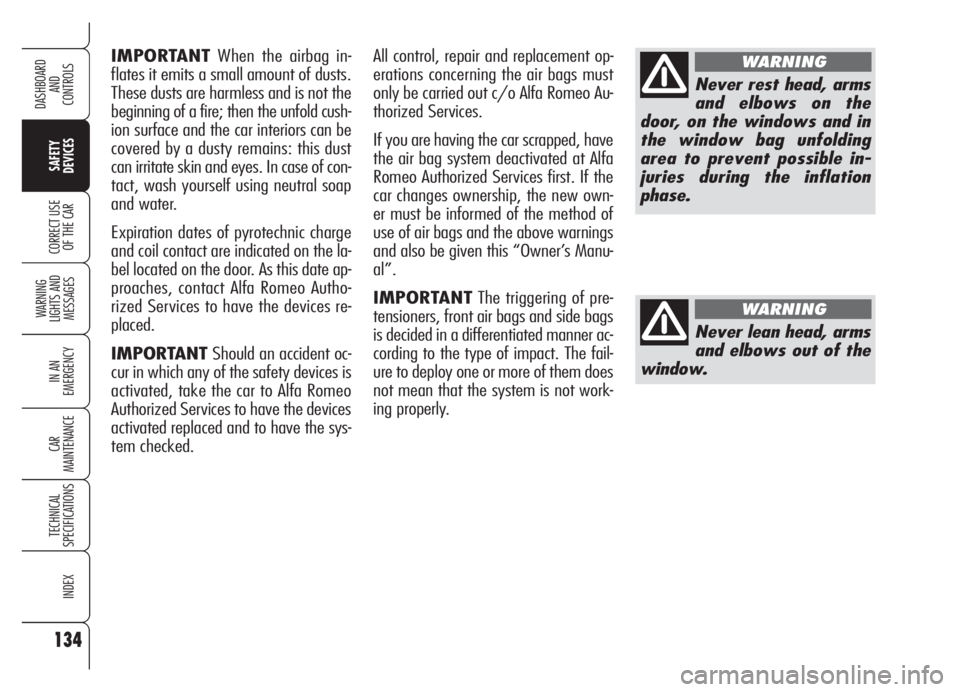
134
SAFETY
DEVICES
WARNING
LIGHTS AND
MESSAGES
IN AN
EMERGENCY
CAR
MAINTENANCE
TECHNICAL
SPECIFICATIONS
INDEX
DASHBOARD
AND
CONTROLS
CORRECT USE
OF THE CAR
IMPORTANTWhen the airbag in-
flates it emits a small amount of dusts.
These dusts are harmless and is not the
beginning of a fire; then the unfold cush-
ion surface and the car interiors can be
covered by a dusty remains: this dust
can irritate skin and eyes. In case of con-
tact, wash yourself using neutral soap
and water.
Expiration dates of pyrotechnic charge
and coil contact are indicated on the la-
bel located on the door. As this date ap-
proaches, contact Alfa Romeo Autho-
rized Services to have the devices re-
placed.
IMPORTANTShould an accident oc-
cur in which any of the safety devices is
activated, take the car to Alfa Romeo
Authorized Services to have the devices
activated replaced and to have the sys-
tem checked.All control, repair and replacement op-
erations concerning the air bags must
only be carried out c/o Alfa Romeo Au-
thorized Services.
If you are having the car scrapped, have
the air bag system deactivated at Alfa
Romeo Authorized Services first. If the
car changes ownership, the new own-
er must be informed of the method of
use of air bags and the above warnings
and also be given this “Owner’s Manu-
al”.
IMPORTANTThe triggering of pre-
tensioners, front air bags and side bags
is decided in a differentiated manner ac-
cording to the type of impact. The fail-
ure to deploy one or more of them does
not mean that the system is not work-
ing properly.
Never rest head, arms
and elbows on the
door, on the windows and in
the window bag unfolding
area to prevent possible in-
juries during the inflation
phase.
WARNING
Never lean head, arms
and elbows out of the
window.
WARNING